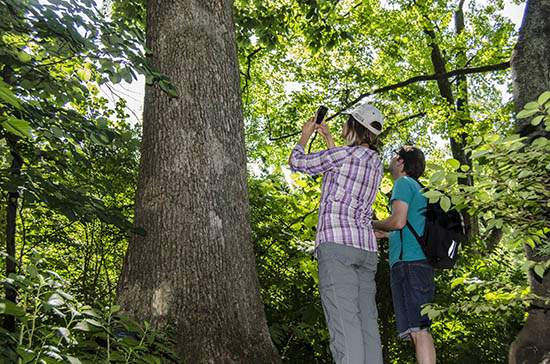New tree app builds partnerships between citizens and scientists
New tree app builds partnerships between citizens and scientists

TreeSnap, new phone app developed by the University of Kentucky Forest Health Research Center and the University of Tennessee Department of Entomology and Plant Pathology for Android and iOS cell phones is designed to connect scientists with foresters, landowners and interested citizens in an effort to protect and restore the nation’s trees.
A team led by Bert Abbott of the UK Forest Health Research and Education Center and a University of Tennessee team led by Meg Staton developed the free app as a part of a $3 million grant from the National Science Foundation Plant Genome Research Program. The partnership is part of a larger collaboration with Washington State University and the University of Connecticut.
One of the team’s objectives in developing the app was to explore how they could engage the public with online resources scientists use for research, explained programmer and UT postdoctoral scholar Bradford Condon.
Every day, American forests fight for their health against invasive species and pests. The app will provide scientists with more eyes in the field, giving them a greater reach to locate resilient trees that will advance their studies, whether they are working on breeding efforts or genomics to help in forest restoration.
“More than 80 percent of Kentucky’s forests are privately owned, so if we have a way to involve those private landowners in some of these processes, it really opens up a lot of potential for researchers. The app gives those who are already in the forest, hiking or surveying their woods, a way to collect data that researchers can access,” said Ellen Crocker, a postdoctoral scholar of eastern forest health issues in the UK Department of Forestry and Natural Resources in the College of Agriculture, Food and Environment.
The app focuses on tree species that have been either negatively affected by an invasive insect or disease or are economically important, such as the white oak.
The developers have partnered with several research and tree breeding programs. The U.S. Department of Agriculture Forest Service Northern Research Station will use data on ash and elm to help them in their fight against the emerald ash borer and Dutch elm disease. The Forest Restoration Alliance and the Hemlock Restoration Initiative will use information on hemlock to find trees that are resistant to the hemlock woolly adelgid. The American Chestnut Foundation is gathering data on trees that are resistant to chestnut blight, in the hopes of adding them to breeding and research programs. UK’s Forest Health Research and Education Center will use records on white oak to build a breeding program in the event that the trees are targeted by invasive pests in the future.
“This is going to be a big advancement in how these organizations currently collect data,” Crocker said.
Abdullah Almsaeed, a UT mobile development specialist, was tasked with making the app easy to use. The app guides the user to collect the necessary data: anything from habitat and crown classification, height and health to the quantity of seeds or cones and tree diameter. Users are encouraged to take pictures of the tree, and GPS on their phones will automatically log the location. The developers recognized that not everyone will have cell coverage in the woods, so the app stores all of the information. When coverage is available, users can simply push a button and upload the data to the TreeSnap server.
To protect the trees and the privacy of landowners, locations on the map, the app randomly alters and reports individuals within a five-mile radius.
The app creators have two groups they are targeting.
“If they’re interested in having this data for their research, they should contact us, and we can tailor the app to their needs,” Condon said.
“For the general public, if you’re interested in being engaged in this kind of citizen science, then by all means, download the app and start using it,” Crocker said. “I highly recommend engaging a local environmental group and organizing a sampling day.”
Crocker is partnering with the Kentucky Master Woodlands Stewards Program, offered by UK forestry extension, to offer training. She also plans to offer workshops in the fall for those interested in learning more about the program.
“We’re really hoping that this app will let people, whether they’re foresters, landowners, or just avid hikers and nature lovers, engage with scientists in meaningful data collection,” Crocker said.
TreeSnap is available in the Apple App Store and Google Play Store. More information is available online at https://treesnap.org.
Extension Forestry & Natural Resources Research

